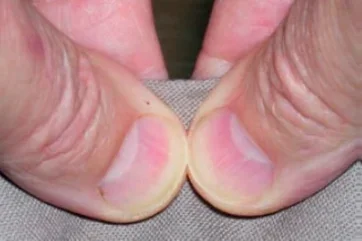
Following WW2, and before the advent of the unit shop, hand cleaning involved the use of both white spirit and water in conjunction with detergents and soap. Today, because of health and safety considerations, hand cleaning is largely confined to the use of water and liquid soaps or detergents. The only exception is limited localised stain removal using a proprietary post-spotter or (preferably) pure chemicals.
Items such as soft toys and small textile items, because of their construction, may require a hand cleaning process. Suede and leather articles contain tanning agents, leather oils, and leather dyes, which may not be fast to water, making them the most at risk from hand cleaning techniques (see our March 2023 article What Went Wrong – Skin Deep). Despite these risks, hand cleaning can be quite straightforward and most experienced cleaners will accept certain items that they know they can successfully hand or surface clean, with little or no risk; but beware, there can be serious risks hiding around the corner to really spoil the day of any cleaner unwise enough to rush in to hand clean any item without properly evaluating its construction, make up, surface appearance and finish.
Today, many cleaners, having experienced difficulties cleaning suede and leather in the past, do not operate an ‘in-house’ service, instead sub-contracting items to a trade specialist cleaner. However, provided very lightly soiled or stained items are carefully assessed, a much better result is often possible by hand cleaning an item, because this can avoid common customer complaints (such as colour variation between panels on suedes or partial loss of pigmentation on leathers) which often occurs in total immersion cleaning processes. In addition, other items, such as boots, shoes and handbags, can be accepted, once the cleaner has acquired the basic knowledge, hands-on skills and confidence to perform the task.
Getting started
This is the first hurdle to overcome and is perhaps best achieved by the process of learning by experience. Start by acquiring a few old items, say from friends, relatives and/or charity shops. Items such as soft toys, a stiffened pelmet, ornamental mats and any textiles that do not lend themselves to dry- or wetcleaning can be used to practice on, as can suede and leather items, such as jackets, handbags, shoes and boots. In the case of suede and leather, it is a good idea to engage in a little background research related to the fundamental properties of both suede and leather.
Acquiring the necessary knowledge and skills may take some time, so initially only accept the easiest and most straightforward items. For your first attempts at hand cleaning, soft toys such as teddy bears are normally very straightforward but always read any attached aftercare labels. The main risk here is with old/very old items, where the fabric may have started to deteriorate, so use a simple strength test before going ahead. Also, the filling can be very much an unknown quantity and could deteriorate when exposed to water so check by wetting a small area before going ahead and if in any doubt, do not accept it for cleaning. Always be on the lookout for loose trims, stuck on eyes and split seams/tears and so on. Items can be cleaned in a bowl or sink and should respond well using warm water and a soft brush, together with a specialist hand-wash, child-friendly detergent. Rinse thoroughly and if any product such as conditioner is used, ensure that it is also child-friendly. Finally, squeeze gently to remove excess water and hang to dry.
Leather and suede
Unlike textiles, leathers and suedes vary considerably in their structure, texture and density. This also applies to skins produced from the same animal and means that the cleaner cannot always rely on a uniform response to hand cleaning products and techniques, particularly when dealing with garments which are likely to have been made up with skins from two or more animals. Bearing this in mind, when hand cleaning, always check and test every step of the way, and do not proceed further until you are entirely confident of a good response.
Grain leather
Following a colour test (allow the solvent to evaporate fully before proceeding), white spirit can be used with care for the removal of localised oil-based marks on grain leathers and pigmented leather items. However, its use should be avoided on suede items; if it is absorbed into the suede, it may cause the oil in the skin to migrate, leaving a light patch surrounded by a darker area This leaves no alternative but total immersion cleaning, to level up the affected area. For grain and pigmented leathers, after first testing in an underarm area or inside facing, lightly moisten a soft white cotton cloth with white spirit and gently wipe the oil-based marks/stains, constantly checking that the colour is not being affected – this may also be successful for removing light spots of emulsion paint.
On grain and pigmented leathers, for water-based stains and light general soiling, using a soft white cotton cloth lightly moistened with Fairy Liquid solution (or previously mentioned products such as specialist soaps), gently wipe and clean the soil/stain marking, then wipe over the areas with a clean damp cloth.
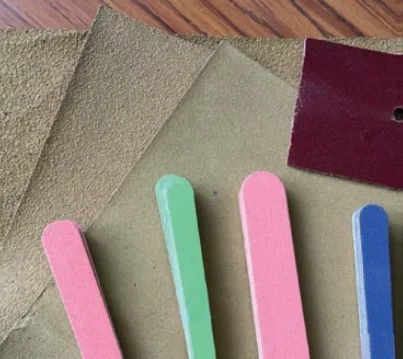
Because of its high oil content, all types of pigskin can be very difficult to clean, with a high risk of localised colour variation/loss. This is particularly the case when removing stains on strong vibrant shades and once general soiling has become embedded it can be impossible to shift it. For these reasons, in our view, pigskin is best avoided by all those but the most experienced staff.
Suede leather
Because suede leathers are produced from the flesh side of the skin, the nap of which absorbs many stain types, the methodology for removing stains and soiling on suede leathers is not the same as for grain leathers, and until you have gained experience, we would recommend that the use of solvents and water should be avoided and soil and stain removal mainly confined to the use of specialist brushes, abrasives, and the use of absorbent powder. Abrasives have been used in the cleaning and restoration of suede leathers for well over 60 years and together with the suede brush are amazingly effective at removing a wide range of stains and soiling. Some suede and leather specialists use a sand blasting cabinet for the preparation of suedes and sheepskin prior to cleaning.
In most cases, a good way to start is to wipe over the item with a microfibre cloth to remove any loose dusty soiling and follow up by brushing all over with a suede brush. This will level up the nap and hopefully remove some of the stains and soiling – if you are lucky, all of it. In the case of any greasy or oily stains, apply a little fullers earth or baby powder to the stain and gently work it in, then leave for around half an hour or more to allow time for the oil to be absorbed. Then brush off and repeat if this is proving effective and finally use abrasive for any residual stain that is not responding. The use of abrasive techniques removes the surface nap that is soiled/stained, whilst simultaneously creating a fresh clean nap. We recommend that you obtain a range of different grit paper products varying from fine to medium; different grades are necessary as the texture of suede leathers is infinitely variable. Sand/grit papers, wet/ dry paper (used dry) or emery paper can be used to lightly sand soiled areas and stains. Water based stains should be dry before attempting to remove them. For smaller stains, emery board nail files are very effective. Finally, brush the area with a suede brush to level the finish.
Examples of items/products used in hand cleaning
- Domestic/commercial upholstery hand cleaning equipment.
- The professional spotting table with vacuum, steam, water spray and hot air drying.
- Various types of suede brush.
- Proprietary leather cleaning products and hand wash products for textiles.
- Fullers earth or baby powder for absorbing oil/grease stains on suede.
- Various abrasive materials (for suede stain removal) fine sandpaper, wet or dry abrasive paper, emery board nail files.
- Fairy Liquid – use up to 20% solution in water for cleaning leather and pigmented leather.
- Specialist leather cleaning products and preservatives.
- Micro fibre cloths.
Case studies
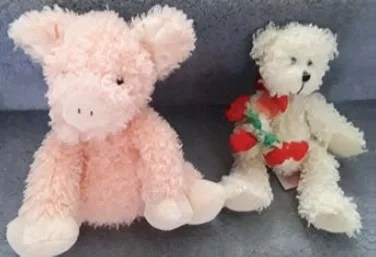
SOFT TOUCH: Soft toys are generally easy to clean but the red trim on the toy on the right would need to be carefully checked for colour fastness. It was also very delicate, so hand cleaning would be essential. In this case we would suggest the use of a child-friendly, colour-safe, hand-wash product
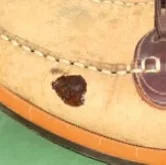
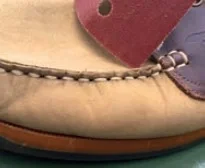
SAND OFF: This was a large tomato sauce stain on a suede and leather shoe. The excess was scraped off and the absorbed component allowed to dry. 600 grade wet/ dry paper was then used on the dry stain. This was not completely successful, and a fine grade DIY abrasive paper (shown) was used to remove the residual stain
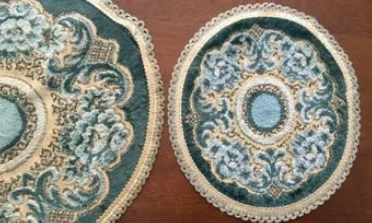
DELICATE OPERATION: After checking colour fastness this very delicate old mat seen on the right (part of a set) was cleaned in a sink. Using a soft brush, the mat was gently tamped with a 15% Fairy Liquid solution and warm water to remove the soiling. After rinsing, it was placed between a terry towel on a flat surface and the excess water pressed out and then allowed to dry flat. This item would not have survived wetcleaning. The weak nature of the fabric is evidenced by the larger soiled mat on the left which has started to deteriorate at the top edge right






